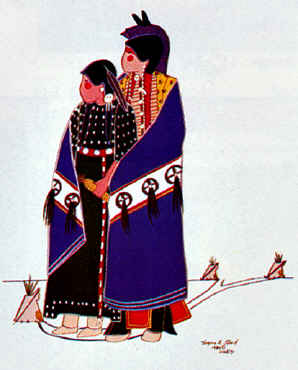|
 Edison
Eskeets, a wiry, youthful man with long black hair, has just run what he calls a "sacred" journey: 375
miles in 10 days on behalf of educational achievement - and hope - among his fellow native Americans. Edison
Eskeets, a wiry, youthful man with long black hair, has just run what he calls a "sacred" journey: 375
miles in 10 days on behalf of educational achievement - and hope - among his fellow native Americans.
Mr. Eskeets grew up in a traditional Navaho family and lived on a farm in a remote part of western New Mexico about
five miles from the Navaho Reservation. He went to college, and says he has always appreciated the exposure it
gave him to different languages, people, and landscapes.
Now, as dean of students at the Native American Prep School (NAPS) here in Rowe, N.M., he is dedicated to ensuring
that other students can pursue their dreams of higher education. Located in the Pecos Mountains about 45 minutes
east of Santa Fe, the residential college was created in 1995 to provide promising native American students with
the chance to excel academically in an environment that values their distinct heritages.
Educators nationwide have expressed concern in recent decades about the need to motivate native Americans to apply
for college, and to help them stick with it until they graduate. Students often have difficulty adjusting to the
college environment, especially when it is far away from their home environment.
Richard Ettinger founded NAPS because he understood this difficulty from first-hand experience. He attended Dartmouth
College in Hanover, N.H., during the 1940s and was disappointed to find no other Indian students, despite the college
charter's commitment to serve the native population.
After funding college scholarships and creating a series of summer institutes on reservations, he came to believe
that improving high school education was key to increasing the success of native American students at college.
NAPS, the fruition of his dream, opened one year before Mr. Ettinger died.
Today, the beautiful campus, which once served as a corporate retreat, hosts 60 students (26 boys and 41 girls)
from 30 tribes and 12 states.
Some of the many tribes represented are the Lakota, Navajo, Chippewa, Laguna Pueblo, Apache, Paiute, Shoshone,
Ponca, Hopi, Pima, Oneida, Omaha, and Potawatomi. While offering a rigorous academic schedule, Eskeets explains,
the school supports students in the values and beliefs they bring from home.
And despite the diversity of tribes, the school achieves a sense of community, where students pull for one another,
students say.
Julia Montour is a Mohawk who grew up in Canada and has been living with her family in Colorado. A freshman this
year, she's enthusiastic about NAPS. "I love having such small classes - my biggest class is 10 students,"
Julia says. "Math, which I used to hate, is now my favorite subject because I've got a teacher who explains
everything so well."
The 14-year-old also appreciates having native American faculty such as Eskeets and Milledge Bennett, a history
teacher.
"It is possible to go a lot further [in discussions] because of the common identity than would be possible
in a multicultural classroom," says Mr. Bennett, who comes from a mixed Creek, Cherokee, and African-American
family in northeast Georgia.
He explains further: "There's a lot of 'insider' information about events that is very interesting. The textbooks
will say one thing, and the students know something else from the stories they've heard from their grandparents
and great-grandparents."
In the NAPS class that graduates this spring is Javier Marquez, whose heritage is a blend of Navajo and Mexican.
He was accepted at six of the seven colleges to which he applied, including the Massachusetts Institute of Technology
in Cambridge and Stanford University in California.
"I think the school is right on track," says Sharon Ettinger, the widow of the school's founder. "Last
year there were 22 graduates, and of these, 20 are still attending college.... Since it's such a small group, we're
staying in close contact with all of them."
Mrs. Ettinger particularly praises Eskeets for being so immersed in his job, and for helping students feel accepted.
Eskeets, a long-distance runner from his youth, raised money for the school on his recent marathon through southern
Colorado and northern New Mexico. "I consider it important to completely balance the physical and mental aspects
of this run," he said before he embarked April 17.
The "miracle run," as it was dubbed, was a spiritual quest, during which he paid homage to Blanca Peak,
a mountain sacred to the Navajos.
At the same time, the marathon provided a means to raise money for NAPS scholarships, so that many more young people
will be able to travel on their own paths toward learning and accomplishment.
National Indian Education Association
http://www.niea.org/
|
 Edison
Eskeets, a wiry, youthful man with long black hair, has just run what he calls a "sacred" journey: 375
miles in 10 days on behalf of educational achievement - and hope - among his fellow native Americans.
Edison
Eskeets, a wiry, youthful man with long black hair, has just run what he calls a "sacred" journey: 375
miles in 10 days on behalf of educational achievement - and hope - among his fellow native Americans.